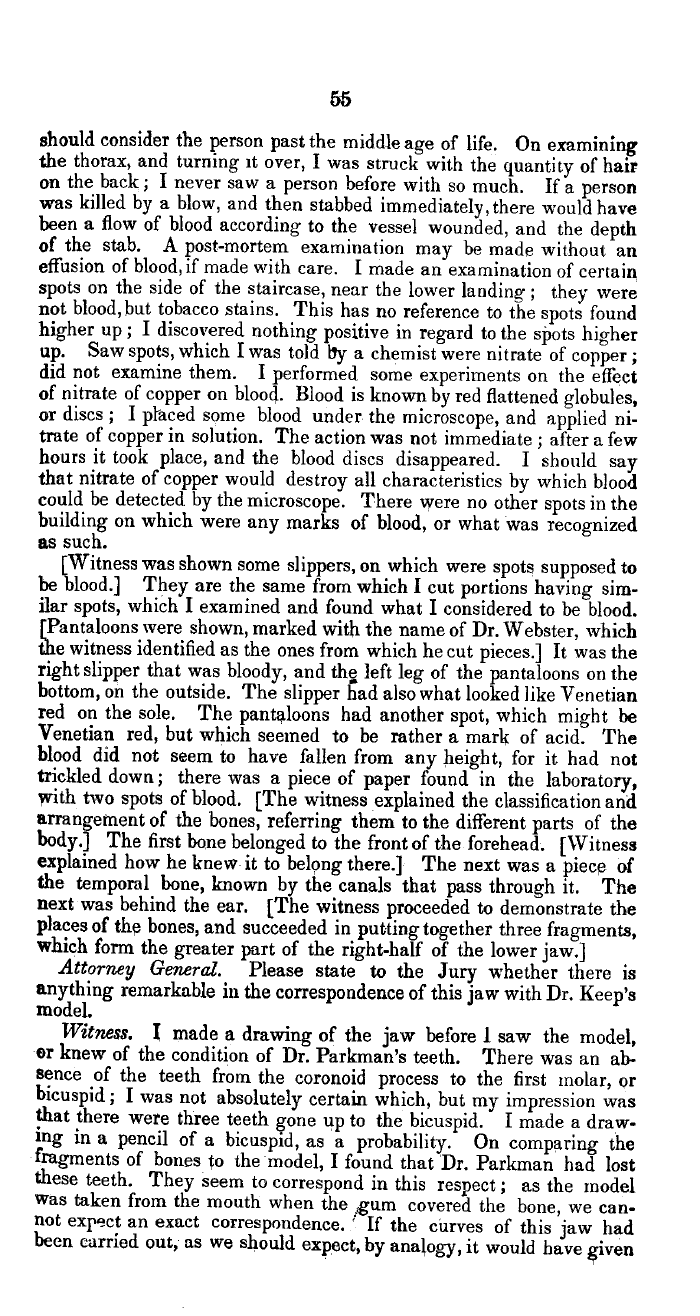|
65
should consider the person past the middle age of life. On examining
the thorax, and turning it over, I was struck with the quantity of hair
on the back; I never saw a person before with so much. If a person
was killed by a blow, and then stabbed immediately, there would have
been a flow of blood according to the vessel wounded, and the depth
of the stab. A post-mortem examination may be made without an
effusion of blood, if made with care. I made an examination of certain
spots on the side of the staircase, near the lower landing; they were
not blood,but tobacco stains. This has no reference to the spots found
higher up; I discovered nothing positive in regard to the spots higher
up. Saw spots, which I was told by a chemist were nitrate of copper;
did not examine them. I performed some experiments on the effect
of nitrate of copper on blood. Blood is known by red flattened globules,
or discs ; I placed some blood under. the microscope, and applied ni-
trate of copper in solution. The action was not immediate; after a few
hours it took place, and the blood discs disappeared. I should say
that nitrate of copper would destroy all characteristics by which blood
could be detected by the microscope. There were no other spots in the
building on which were any marks of blood, or what was recognized
as such.
[Witness was shown some slippers, on which were spots supposed to
be blood.] They are the same from which I cut portions having sim-
ilar spots, which I examined and found what I considered to be blood.
9Pantaloons were shown, marked with the name of Dr. Webster, which
e witness identified as the ones from which he cut pieces.] It was the
right slipper that was bloody, and the left leg of the pantaloons on the
bottom, on the outside. The slipper had also what looked like Venetian
red on the sole. The pantaloons had another spot, which might be
Venetian red, but which seemed to be rather a marls of acid. The
blood did not seem to have fallen from any height, for it had not
trickled down; there was a piece of paper found in the laboratory,
with two spots of blood. [The witness explained the classification and
arrangement of the bones, referring them to the different parts of the
body.] The first bone belonged to the front of the forehead. [Witness
explained how he knew it to belong there.] The next was a piece of
the temporal bone, known by the canals that pass through it. The
next was behind the ear. [The witness proceeded to demonstrate the
places of the bones, and succeeded in putting together three fragments,
which form the greater part of the right-half of the lower jaw.]
Attorney General. Please state to the Jury whether there is
anything remarkable in the correspondence of this jaw with Dr. Keep's
model.
Witness. I made a drawing of the jaw before I saw the model,
or knew of the condition of Dr. Parkman's teeth. There was an ab-
sence of the teeth from the coronoid process to the first molar, or
bicuspid; I was not absolutely certain which, but my impression was
that there were three teeth gone up to the bicuspid. I made a draw-
ing in a pencil of a bicuspid, as a probability. On comparing the
fragments of bones to the model, I found that 'Dr. Parkman had lost
these teeth. They seem to correspond in this respect; as the model
was taken from the mouth when the ,gum covered the bone, we can-
not expect an exact correspondence. ` If the curves of this jaw had
been carried out; as we should expect, by analogy, it would have given
|

